Scrapbook For The Rotary Year July 2021 to June 2022
(in reverse date order)
11th July - Monthly Walk
Our walk of just under four miles long, started and finished at the Red Cow in the village of Chrishall. Chrishall Common at 482 feet
is the highest point in Essex.
Recorded in the 1086 Domesday Book in the hundred of Uttlesford with 58 households and 8 slaves, Chrishall in size is in the top
20% of settlements in England. It has not changed a lot in almost a thousand years. The land at that time was assigned to Count
Eustace of Boulogne by William the Conqueror for his support in the battle of Hastings.
27th July - Presidential Handover
This
event
was
the
first
time
in
some
sixteen
months
since
the
Royston
Rotarians
had
been
able
to
meet
together
socially.
Thirty
six
members
and
guests
met
at
the
Garden
Room
at
Chilford
Hall
near
Linton
at
6.30
pm.
The
event
had
been
delayed
due
to
the
Government
covid
restrictions
and
despite
the
fact
that
the
event
could
at
last
go
ahead
all
guests
had
to
book
in
with
a
Test
and
Trace recording.
Guests
were
met
with
a
Bucks
Fizz
drink
and
canapés
and
were
able
to
mingle
and
chat
for
the
first
time
in
ages.
A
delicious
meal
followed served by carefully masked waiters.
Following
the
meal
the
formal
proceedings
began
with
President
Martin
Berry
(who
had
diligently
served
for
a
continuous
two
year
stretch)
addressing
the
attendees
before
passing
on
the
chain
of
office
to
our
new
president
Stephen
Higginbotham.
The
twist
here
was
that
due
to
social
distancing
limitations
of
covid
President
Stephen
had
to
place
the
chain
on
himself
rather
than
have
the
past
president
place it round his neck.
Sue
Higginbotham
was
presented
with
the
Lady’s
Jewel
by
Martin’s
partner
Josephine
who,
in
turn
was
presented
with
some
white
orchids
to
thank
her
for
all
her
support
over
the
last two years.
After presenting the vice president’s Jewel to Peter Mitton and
the past president’s jewel to Martin, President Stephen made
an address where he thanked the past president and his
council members.
With the formalities out of the way the attendees were able to
chat with each other long and animatedly, something they
had all been missing for far too long.



27th July - Award of Paul Harris Fellowships
As
one
of
his
final
duties,
outgoing
President
Martin
Berry
announced
two
Paul
Harris
Fellowships
at
the
Presidential
Changeover.
These
fellowships
are
usually
awarded
for
service
to
the
club
over
and
above
what
would
be
expected.
Paul
Harris
Fellow
recognition
was
created
in
memory
of
Paul
Harris,
the
founder
of
Rotary.
It
has
been
a
practice
of
many
clubs
to
award
Paul
Harris
Fellowships
in
appreciation
of
his
or
her
service
to
the
club
or
the
local,
national
or
international
community.
The
citations
announced
by
President Martin was as follows.
“
It is my very great honour to present not one, but two Paul Harris Fellowships this evening.
The
first
goes
to
someone
who
has
found
the
past
18
months
more
restrictive
than
most
of
us
but
who,
in
spite
of
that,
has
continued
to
be
particularly
active
within
club.
When
we
were
no
longer
able
to
meet
in
person,
he
suggested
we
should
meet
on
Zoom
and
helped
the
less
computer
literate
of
us
to
master
this
new
technology.
When
we
had
to
cancel
our
fund-raising
events,
he
suggested
we
should
raise
money
online
with
a
virtual
balloon
race.
And
when
we
were
approached
by
a
scurrilous
organisation
about
a
ludicrous
copyright
infringement
he
responded
quickly
and
very
professionally
to
manage
our
risk
and
help
Council
deal
with
the
situation.
And,
on
top
of
all
this,
throughout
the pandemic he has kept our “shop window” – our website - up to date and interesting.
I am, of course, talking about
Tony Briar.
The
second
Paul
Harris
Fellowship
goes
to
someone
else
who
has
kept
himself
busy
on
the
Club’s
behalf
throughout
the
Pandemic.
He
has
managed
to
become
a
very
successfully
blogger
without
even
knowing
what
a
blogger
is!
His
ad-hoc
musings
have
gained
a
wide
following
and
kept
many
people,
some
of
whom
are
living
in
difficult
circumstances,
entertained
and
connected
during
the
lonely
days
of
lock-down.
He
was
the
driving
force
behind
the
creation
of
our
Memory
Café,
and
he
is
always
looking
for
ways
to
help
the
less
fortunate
in
our
community.
To
that
end,
he
has
served
for
several
years
as
a
Trustee
of
the
Deard’s
Trust
and
has
been
particularly
busy
in
that
role
throughout
the
pandemic.
He
helped
our
new
President
set-up
a
committee
to
look
at
the
future
of
the
club
and
he
has
given
us
two
excellent
talks
on
Zoom
–
both
finishing exactly on time.
I am, of course, talking about
David Izod.”
Sadly,
Tony
had
to
cry
off
from
the
event
due
to
illness
but
David
was
able
to
accept
the
Paul
Harris
Fellowship
award
in
person
as
shown
in
the photo.

11th July - Monthly Walk
Our walk of just under four miles long, started and finished at the Red Cow in the village of Chrishall. Chrishall Common at 482 feet
is the highest point in Essex.
Recorded in the 1086 Domesday Book in the hundred of Uttlesford with 58 households and 8 slaves, Chrishall in size is in the top
20% of settlements in England. It has not changed a lot in almost a thousand years. The land at that time was assigned to Count
Eustace of Boulogne by William the Conqueror for his support in the battle of Hastings.
The barn of the Red Cow, in the back ground to the picture on the
left, was built in the 15th century and is the oldest building in the
village. The pub itself was much modified in the 17th century.
We started the walk by crossing the road and sports field before turning right on reaching a lane. The various thatched cottages on
our left dated back several centuries. After passing the pond to our right we cut back through the trees to the road leading to the
crossroad and memorial with the Red Cow on our right.
At the top of Church Road we turned down Loveday Close. On turning right at the end we walked along the edge of the fields to a
lane. At the lane we turned left to the end of the wood to get a view across the Cambridge countryside to the tower of Ely
Cathedral in the far distance. You will need your binoculars to see it on a good day.
Retracing our steps we continued along the edge of what is known locally as Bluebell Wood, a blaze of colour when the spring
bluebells are in full bloom, to a crossroad. To our left is the village of Elmdon and to our right the village of Chrishall. We crossed
the lane keeping the woodland on our right until we reached the fence paddocks of Hugo Lascelles Bloodstock situated in Elmdon,
where we stopped for a coffee break. It was along this stretch of walk that John Wahlich remarked how easy it is to lose ones
orientation on these walks and I remarked only a blind man could lose his way on this walk.
After the coffee break to prove John’s point I had to eat my words. Instead of orientating myself I set off towards Pond Street before
having to retrace my steps and turning towards Chrishall Holy Trinity Church. I have always done this walk the other way round but
changed it to have a suitable break for coffee.
With the private wood on our right we had a beautiful view across the undulating Essex countryside with Chiswick Hall on the far
side of the B1039. This was the site of Flanders House, not that of the Simpsons, but that of Count Eustace of Boulogne, whose
daughter Matilda married King Stephen. The remains of the fish pond and moat can still be found in the grounds of the house.
On reaching the Church we crossed the church yard and descended to Church Road. The current flint built church dates back to the
12th Century. On crossing the road we followed the path up to Chalky Lane passed the hand pump which used to draw its water
from the chalk aquifer, on to Hogg's Lane and the Red Cow and a pint of ale and a good meal. A pleasant and enjoyable stroll after
all of the confinement.
Jim Webb
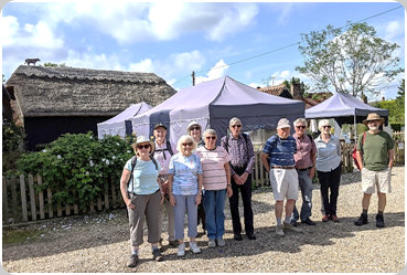
The
weather
prediction
for
the
August
walk
promised
rain
from
about
1.00pm
and
luckily
it
followed
the
script,
with
a
substantial
downpour
occurring
soon
after
we
were
ensconced
comfortably
in
a
marquee
at
the
Fox
and
Duck
in
Therfield.
Well
maybe
not
quite
so
comfortably
as
a
heater
was
turned
on
that
proceeded
to
cook
the
occupants
to
medium
rare
until
it
was
turned
off
after
a request from the sweating diners.
The
walk
was
unusual
in
that
it
allowed
options
of
0,
2,
4,
6,
8
and
10
mile
circuits.
Only
Sandra
Scott
joined
Ray
to
walk
the
2
miles
from
his
house
to
meet
everybody
else,
now
totalling
8,
at
the
F&D
to
set
off
for
the
4
mile
circuit
-
after
the
obligatory
photograph
of course.
The
walk
started
off
north
before
joining
the
path
following
to
the
East
along
a
ridge
with
spectacular
views
across
miles
of
Hertfordshire
as
well
as
a
vast
expanse
of
Cambridgeshire.
It
is
possible
from
a
single
spot
on
this
ridge
to
see
the
tall
transmitter
aerial
on
Sandy
Heath,
Wimpole
Hall
and
its
folly,
Ely
Cathedral
(some
34
miles
away),
a
water
tower
(some
40
miles
distant)
in
Littleport
(Barbara
Mitton’s
birthplace
apparently
–
Littleport
that
is,
not
the
water
tower),
lots
of
Cambridge
including
Kings
College
Chapel
and
Addenbrookes,
Great
Chishill
windmill
and
Peter
Homent’s
and
Neil
Heywood’s
houses. The only part of Royston visible is the tip of the 4 chimney stack in Johnson Matthey.
Turning south we found our way to Reed End where, peeping over a high hedge, a cottage displayed a rather nice weather vane.
We
followed
the
road
towards
Dane
End
but
turned
west
onto
a
footpath
across
the
fields
to
Rooks
Nest
Lane.
Here
after
a
short
southerly
walk
we
once
again
turned
west
onto
a
footpath,
Ray
having
been
disappointed
that
a
house
that
normally
displayed
several
high
performance
cars,
including
a
couple
of
Maclarens,
was
on
this
occasion
merely
offering
an
Aston
Martin
SUV.
A
further
annoyance
on
this
route
was
that
in
several
places
the
farmer(s)
had
ploughed
right
up
to
the
edge
of
the fields, leaving slightly difficult walking and no margin for wildlife.
We
followed
various
paths,
hugging
field
sides
until
we
skirted
briefly
through
Kelshall
and
then
back
across
to
Therfield
Church
and
from
there
onto
the
Fox
and
Duck,
where
we
were
joined
by
Tony,
Kash
and
Di for a very nice lunch. Those choosing Sunday lunch were mostly defeated by the giant Yorkshire puddings.
The rain deterred even Sandra and Ray from walking back to Royston and so only the 4 and 6 mile walks were completed.
Words and Pictures by Ray Munden


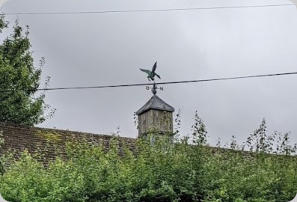

The walking group waiting in anticipation
No photo can do justice to the view across Cambridgeshire
The Striking Weather Vane
15th August - President’s Hello
At last we were to have the President’s Hello, much delayed from the month of July when we normally have this highly anticipated
event. The origins of the event are lost in the mists of time but it allows all Rotarians and their partners to meet the new president
for the year in an informal setting.
The setting this year was President Steve and wife Sue’s lovely garden situated in a quiet and secluded part of Royston and on a
beautifully sunny afternoon. The event was very well attended and we all sampled the extensive array of drinks on offer. After much
catching up among friends it was time to eat, alfresco naturally, and what a feast lay before us. Quite apart from the hard work of
preparing the salads and cold meats by Sue and Steve, other Rotarians (or more often their partners) had also contributed to the
feast.
So we sat in the sun, contentedly chattering and munching away until it was time for the sweet courses - always the most anticipated
part of any meal. Once again we were faced with delicious-looking sweet dishes (all ever so slightly fattening to the waistline!). With
Steve serving out strong coffee to finish I think we can remember a really great meal in lovely surroundings and with like-minded
friends,
A
big
thank you to Steve and Sue, and to all the other contributors who had worked so hard in the preparation. Photos below (they
automatically slide in at 8 seconds but you can use the arrows at each side of the picture to step forward or back at your own pace).
Pictures Courtesy of Steve Higginbotham
8th August - Monthly Walk
31st August - Presentation to the Photographic Contest Winner
A
highly
talented
young
local
photographer
was
recognised
this
week
by
Royston
Rotary
Club.
President
Stephen
Higginbotham
was
delighted
to
present
a
certificate
to
Jack
Kirby,
aged
11,
in
recognition
of
his
significant
achievement.
Jack,
who
lives
in
Foxton,
reached
the
national
finals
of
Rotary’s
Young
Photographer
after
earlier
this
year
winning
the
junior
category
in
a
local
contest
organised
by
our
cklub.
He
then
went
on
to
win
at
the
district
level
(covering
Herts,
Beds
and
Bucks),
securing
entry
to
the
national
finals.
Although
he
did
not
win
nationally,
his
photograph,
‘Nature
co-existing
with
Man’,
which
depicts
a
misty
view
of
the
church
of
St
Laurence,
Foxton,
greatly
impressed
the
judges
with
its
quality
and
composition.
He
was
told
“many
adults
would
have
been
proud
to
have
taken
it.
You
have
the
framing
just
right
and
a
beautiful
depth
of
field,
with
a
spider’s
web
pin
sharp and the church thrown out of focus to provide the perfect backdrop.”
Presenting
Jack
with
his
certificate
outside
Foxton
church
(above),
Mr
Higginbotham
congratulated
him
on
his
achievement
and
hoped
that
he
would
enter
this
year’s
competition, which Royston Rotary Club will be launching soon.
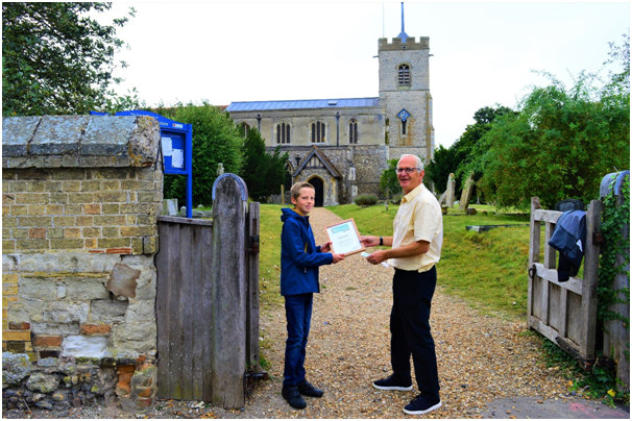
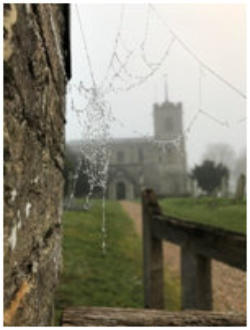
1st September - President’s “Weekend”
The
quotation
marks
above
are
intentional
-
it
was
decided
that
the
much
delayed
President’s
Weekend
for
past
president
Martin
Berry
would
be
held
midweek
for
a
change.
This
year
the
trip
would
be
down
to
Wiltshire,
near
to
Martin’s
old
stomping
grounds
and
was
meticulously
planned
by
Jonathon
Berks
(with
no
doubt
a
lot
of
assistance
from
both
Linda
and
Josephine).
The
Luxury
Richmond’s
coach
picked
us
up
in
stages
from
Barley
to
Green
Drift
in
Royston
and
we
set
off
to
Beaconsfield
to
visit
the
Bekonscot
Model
Village
and
Railway,
claimed
to
be
the
worlds
oldest
original
model
village
(
www.bekonscot.co.uk
).
On
arrival
we
met
up
with
Graeme
and
Linda
Dargie
and
David
and
Glynis
Smyth
who
had
travelled
by
car
from
Royston.
We
weren’t
disappointed
at
Bekonscot,
every
facet
of
British
life
from
the
complete
20th
century
was
there
in
miniature
and
in
meticulous
detail.
And
who
can
forget
the
tongue-in-cheek
(if
slightly
corny)
names
of
many
of
the
miniature
shops
e.g.
“Len
D
Cash,
Pawnbrokers”, “Daily Reed, Newsagents” etc (See the
picture gallery
).
Back
on
the
coach
we
travelled
down
to
Great
Missenden
for
lunch
at
the
Cross
Keys
pub
where
we
had
pre-ordered
our
lunch
selections,
before
wandering
around
the
town
itself
for
half
an
hour
or
so.
We
had
originally
wanted
to
visit
the
Roald
Dahl
museum
in
the
High
Street
but
they
weren’t
geared
up
to
accept
large
groups
whilst
covid
restrictions
were
still
in
force.
Back
to
the
coach
which
took
us
to
the
little
village
of
Wroughton
and
the
Alexandra
House
Hotel
where
we
met
up
with
Mike
Taylor,
ex
Royston
Rotarian,
and
his
partner
Ruth.
That
evening
we
all
met
up
for
a
very
pleasant
dinner
in
one
of
the
hotel’s
function
rooms.
(See
the
picture gallery
).
Thursday
morning
we
all
set
off
after
breakfast
to
visit
the
village
of
Lacock
(
www.nationaltrust.org.uk/lacock-abbey-fox-talbot-
museum-and-village
).
This
picturesque
Wiltshire
village
dates
from
the
13th
century
and
nowadays
is
owned
almost
exclusively
by
the
National
Trust
to
maintain
a
very
rustic
charm.
It
won’t
surprise
visitors
to
know
that
it
is
a
very
popular
filming
location,
Harry
Potter,
Downton
Abbey,
Cranford,
Pride
and
Prejudice,
to
name
just
a
few.
In
addition
the
village
boasts
Lacock
Abbey,
originally
a
13th
Century
nunnery
but
with
its
upper
floors
converted
for
more
comfortable
country
house
living
following
the
Dissolution.
The
Abbey is also home to the Fox Talbot museum, “Britain’s birthplace of photography”. (See the
picture gallery
).
Mid
afternoon
we
set
off
back
to
our
hotel
via
Avebury
(stone
circles)
for
a
rest
and
a
change
of
clothes
before
setting
off
in
the
early
evening
to
the
GWR
Steam
Museum
(
http://www.steam-museum.org.uk/
)
in
nearby
Swindon.
Here
we
were
given
a
guided
tour
by
an
experienced
old
railwayman
who
was
able
to
explain
the
beginnings
of
the
Great
Western
Railway
and
Swindon’s
central
role
in
its
development.
We
toured
the
exhibits,
marvelling
at
the
size
of
some
of
the
steam
engines,
before
having
dinner
in
one
of
their
function rooms. Eventually, back on the coach to return to our hotel well before 10pm. (See the
picture gallery
).
Friday,
being
our
last
day,
we
all
checked
out
of
our
hotel
to
set
off
for
Henley-on-Thames.
Here
we
met
up
with
our
guide
Graham,
who
walked
us
around
parts
of
the
town
pointing
out
various
bits
of
history.
This
town
is
evidently
also
a
favourite
place
for
filming,
particulary
scenes
from
Midsomer
Murders,
and
Graham
was
able
to
point
out
various
locations
used
in
the
many
episodes.
Once
the
walking
tour
was
over
we
all
boarded
a
pleasure
cruiser
from
Hobbs
of
Henley
for
a
two
hour
boat
trip
upstream
and
back,
including
traversing
Hambleton
lock.
We
were
treated
to
a
very
acceptable
buffet
lunch
on
the
boat
so
that
we
could
see
the
sights
passing
by
as
we
ate
our
food
and
listened
to
Graham
describing
points
of
interest.
Having
a
licensed
bar
on
the
boat
was
a
bit
of
a
plus, too. (See the
picture gallery
).
Finally,
we
boarded
the
coach
to
return
to
Royston
where
we
arrived
safely
about
5.30
having
successfully
negotiated
both
the
M40
and the M25 on a typical Friday afternoon/evening.
Special
thanks
to
Jonathon
(and
his
helper
elves)
for
organising
such
a
faultless
trip
-
everything
went
like
clockwork!
(Word
is
that
President Steve is also using Jonathon’s talents for his own President’s Weekend next year).
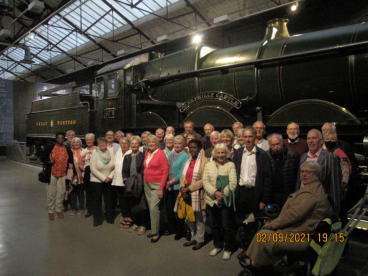
Group photo at GWR Museum
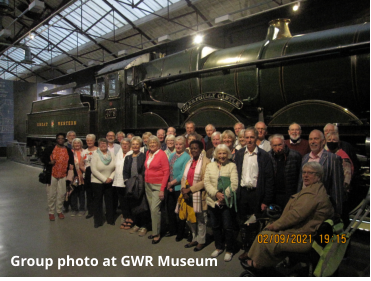
27th September - Results of Creative Writing Competition
The
Rotary
Club
is
delighted
to
have
played
a
major
role
in
overseeing
Royston
Arts
Festival’s
Creative
Writing
Competition.
Winners
have now been announced in the four categories and prizes of tokens for David’s Bookshops, Letchworth, have been distributed.
Rotarian
David
Blundell,
an
organiser
and
judge,
said:
“The
standards
of
entries
were
really
high
once
again.
It
was
very
encouraging
that so many youngsters in the 7-10 years group took part.”
Carl
Filby,
Chair
of
Creative
Royston,
said:
“Thank
you
to
all
those
who
entered
the
competition
and
congratulations
to
the
prize
winners.
We
would
particularly
like
to
thank
Rotary
and
David’s
Bookshop
for
their
support.
Together,
they
covered
the
cost
of
prizes amounting to £300.”
Three
judges
from
the
world
of
literature
and
journalism,
selected
the
following
winners
(full
details
can
be
found
at
http://www.creativeroyston.org/
):
7-10 years
Joint-Winner: Priscilla Tibenderana (9) New Life
Joint-Winner: Nathan Tibenderana (7) Dinos and me
Runner-up: Freya Johnson (8) The four heroes
11-14 years
Winner: Genevieve Eaton-Banks(13) The Refugee
15-18 years
Winner: Elizabeth Eaton-Banks (18) Phoenix
Runner-up: Jasmine Brett(16) I’m a Were-What?
19+
Winner: Justine Blaydon. In the deep woods
Highly recommended other entries
Amelia Keen (8) Moving to Italy
Edward Scales(8) A new person
Darcey Brown (8) The girl who helped the world
Imogen Clements(11) The heavens spoke to me
27th September - Results of Creative Writing Competition
1st to 4th October - A Kentish Adventure
The
journey
is
part
of
the
fun,
they
say.
Not
on
a
Friday
during
a
national
fuel
shortage
it
isn’t,
and
not
on
a
Monday
when
you’ve
been
stationary
on
the
A2
for
an
hour
trying
to
reach
a
7
mile
jam
on
the
M25
(accident
in
the
Dartford
tunnel).
What
happened
between these annoyances was luckily much more enjoyable.
The
club’s
2021
walking
weekend
took
place
in
Kent.
It
was
delayed
a
year
thanks
to
the
unmentionable,
but
it
was
well
worth
the
wait.
Peter
Mitton
had
discovered
our
base:
Knowlton,
an
estate
not
far
from
Canterbury,
consisting
of
1900
acres
of
farmland
surrounding
a
splendid
18C
mansion,
with
several
buildings
repurposed
as
holiday
lets.
Our
home
for
the
weekend
was
the
biggest
and
finest
of
these;
the
10
bedroom
17C
Dower
House.
Well
up
the
high
standards
of
previous
years,
the
handsome
Jacobean
pile
was
provided
with
all
our
basic
needs
(except,
on
occasions,
hot
water)
and
we
arrived
laden
down
with
the
rest.
Everybody
had
contributed
something:
wine,
beer,
cheese,
bread,
a
wonderful
variety
of
cakes
(thanks,
all
you
Rotary
bakers),
sausages,
potatoes,
lamb
chops,
chicken,
plus
big
dishes
of
pre-cooked
curry
and
lasagne.
We
seemed
unlikely
to
starve,
nor
to
suffer
from
alcohol
deprivation.
After
we
settled
in,
it
was
off
for
supper
in
the
pub
at
nearby
Chillenden.
Some
brave
souls
even
chose
to
walk
there
and
back,
no
doubt
getting
in
training
for
the
next
day’s
trek,
planned
for
us
by
John
and
Clarice.
The
scheme
was
to
drive
to
nearby
Deal,
leave
our
cars
at
the
station,
then
walk
along
the
coastal
path
to
Sandwich.
From
there
we
could
catch
a
train
back
to
our
start
point.
I
liked
Deal;
old
fashioned
and
unpretentious,
with
quirky
seaside
teashops,
Dickensian
lanes,
and
a
general
air
of
19th
century
cheeriness.
Most
of
us
obediently
followed
John
to
the
end
of
Deal’s
long
and
very
windy
pier
and
then
(as
is
the
way
with
piers)
back
again.
Some
people
spotted
a
seal,
and
we
all
admired
the
town’s
diverting
roofscape
as
viewed
from
offshore.
Then
away
to
the
north
we
went,
sharing
the
stony
path
with
many
dog
owners.
Deal’s
last
villas
on
our
left
were
succeeded
by
a
golf
course,
with
the
steep
pebble
beach
and
the
grey
Channel
always
on
our
right.
More
nature
notes:
even
more
surprising
than
the
seal
were
the
two
hardy
middle
aged
ladies
we
spotted
frolicking
in
the
brown
waves.
A
rare
sighting
for
October.
The
gusty
wind
was
strengthening
at
our
backs
and
the
clouds
were
gathering
over
the
sea,
but
it
stayed
dry
until
we
stopped
for
a
break
opposite
the
Yacht
Club’s
grand
HQ.
There,
as
we
sipped
our
Thermos
tea,
the
rain
started.
Hoods
and
my
Rotary
brolly
went
up,
then
off
we
trudged
again,
now
with
another
golf
course
on
our
left
-
the
prestigious
Royal
St
George’s,
where
doubtless
Jack
Nicklaus
and
Bobby
Jones
once
hunted
for
lost
balls
in
the
cruel
rough.
One
of
our
number
found
two
of
them
(lost
balls,
not
golfers)
while
taking
a
discreet comfort break behind a bush.
The
path
now
left
the
coast
and
headed
inland.
We
crossed
the
golf
course,
a
typical
links
with
hills
and
hollows,
but
mercifully
dry
underfoot
thanks
to
the
sandy
soil.
Soaking
wet,
we
must
have
looked
a
little
like
Napoleon’s
army
retreating
from
Moscow,
although
there
was
no
snow,
and
we
didn’t
have
to
eat
any
horses.
The
course
then
gave
way
to
a
long
snicket
(as
we
say
in
East
Yorkshire)
–
a
narrow
path
overhung
with
briars,
which
continually
snagged
my
umbrella
until
it
collapsed
and
had
to
be
chucked
into
a
bin.
I
was
soon
as
wet
as
everyone
else.
It
seemed
a
very
long
way.
Finally,
the
streets
and
houses
of
Sandwich
appeared.
We
were
cheered
to
spot
two
restaurants
here,
yards
apart
and
both
selling
pizza.
We
split
into
two
parties
and
crowded
into
both,
greedy
for
Quattro
Stagioni
and
toilets.
Afterwards,
warmer
and
a
little
drier,
we
emerged
into
the
soaking
streets
and
dashed
through
the
rain
to
the
station,
where
we
bought
our
tickets
from
a
machine,
considerately
placed
outside
the
locked
building
and
sited
so
that
the
drips
from
the
roof
fell
on
purchasers’
heads.
It
was
like
using
a
fruit
machine;
some
people
got
one
ticket,
some
two,
and
one
lucky
Rotarian
got
four.
We
all
seemed
to
pay
different
amounts.
But
the
train
came
soon,
and
it
delivered
us
back
to
Deal
in
a
very
few
minutes. It was still raining.
Back
at
Knowlton,
dry
clothes
replaced
wet,
and
tea
and
more
wonderful
cakes
made
a
good
finale
to
a
memorable
walk.
Someone’s
fitness
app
said
we
had
achieved
17,000
steps.
That
would
be
about
7
or
8
miles,
though
John
assured
us
it
was
less.
Miles
seem
longer
in
bad
weather,
but
whatever
the
distance
we
had
a
truly
enjoyable
walk.
There
was
certainly
a
sense
of
achievement
in
finishing it.
Supper,
taken
round
the
Dower
House’s
enormous
table,
featured
Kash’s
chicken
curry
(plus
trimmings
courtesy
of
Jonathan)
and
Lyn’s
lasagne.
Both
were
splendid,
as
was
what
followed:
Sandra’s
bread
pudding,
Jo’s
chocolate
mousse,
and
Joan’s
pear
frangipani
tart.
Sunday was dry!
We
started
the
day
with
a
visit
to
Goodnestone
House
and
Park,
which
has
a
fine
garden.
We
met
the
knowledgeable
head
gardener,
Paul.
He
explained
a
little
of
the
history
of
the
place.
Jane
Austen
was
a
frequent
visitor.
Her
brother
had
married
into
the
Fitzwalter
family,
who
built
the
house
and
still
live
there.
It’s
now
marketed
for
weddings
and
suchlike,
so
it
would
be
ideal
for
another
Rotary
walking weekend. Three nights self-catering costs just shy of £10,000 in peak season. Well, perhaps not.
After
lunch,
it
was
back
to
the
coast
again;
this
time
to
Walmer,
south
of
Deal,
a
Cinque
Port
with
a
castle
where
Wellington
died.
A
much
more
leisurely
expedition,
this
one;
we
strolled
along
the
coast
path
to
Deal
past
innumerable
‘in
memory
of’
benches
and
fishing
boats
hauled
up
on
the
shingle,
and
then
paid
a
visit
to
the
town’s
charming
small
museum,
a
lovely
maritime
jumble
of
pictures
and
models
of
ships
and
sailors
and
lifeboats,
and
long
gone
Deal
shop
signs.
It
was
a
bit
like
our
Royston
Museum;
friendly,
eclectic, and staffed by enthusiastic volunteers. Then we strolled back to Walmer again. Time to finish off that cake!
The
grand
finale
was
Sunday’s
barbecue.
David
Beardwell
and
President
Steve,
boldly
wielding
enormous
tongs
amid
clouds
of
smoke,
laboured
over
the
modest
Weber
kettle
in
the
courtyard,
and
there
was
salad
and
jacket
potatoes
to
go
with
the
grilled
meats.
How
they
produced
so
much
on
such
a
small
barbie
is
a
mystery,
but
it
all
tasted
very
good.
John
Wahlich’s
signature
ginger,
cream
and
orange
pudding
made
a
ceremonial
appearance
afterwards,
and
was
judged
excellent.
John
and
Clarice
had
produced
quizzes,
too,
which
entertained
us
in
the
sitting
room
after
the
meal,
John’s
featuring
the
fiendish
standard
of
difficulty
we’ve
come
to expect from him.
As
ever,
Rotary
fellowship
kept
us
all
smiling,
Rotary
cookery
kept
us
very
well
fed,
and
Rotary
management
made
sure
nothing
went
wrong.
Everyone
who
was
there
did
something
to
deserve
a
big
round
of
applause,
and
that,
when
you
think
about
it,
is
what
makes
the world go round.
What a weekend it was. Who cares about a bit of rain? We had a wonderful time.
Words and pictures thanks to Neil Heywood.
To see the photo album of the visit click here.
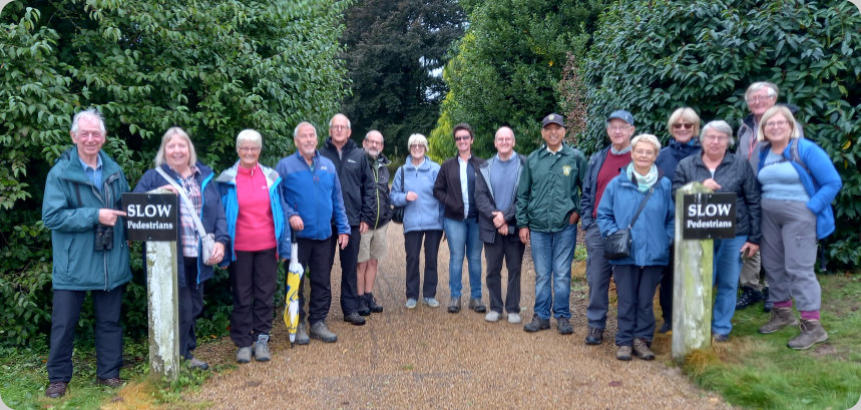
November - Monthly Walk
This is a very brief account of our walk around Abbotsley near St.
Neots..
We set off from the Eight Bells public house on a glorious
autumn day wit the sun shining on gold and yellow leaves as
they floated gently to the ground on a cool breeze. The walk
around Abbotsley was about four and a half miles long over a
gently rolling countryside which gave us some delightful views of
west Cambridgeshire
At the end of the walk, when we got back to the village green, we
found a special memorial to commemorate Armistice Day.
The memorial reads:
In Memoriam
1914 - 1918
The trees on the village green
were planted to honour
the men of Abbotsley who
died in WW1
Lest we forget
We also found some very moving tributes to four brothers, all of whom volunteered at the start of the War, and all of whom were
killed. Here are two of the tributes
ALBERT PAGE
Who lived in Abbotsley on
HIGH GREEN
Gave all whilst serving in ‘the Great War’: son of James & Esther, Albert was a stretcher-bearer in the R.A.M.C before he was killed in
action in Cambrai on 27/9/1918
ALL GAVE SOME
SOME GAVE ALL
Lunch at the Eight Bells was extremely good value for money!
Story by Martin Berry
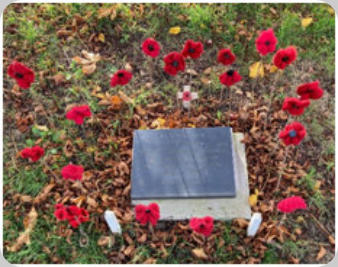
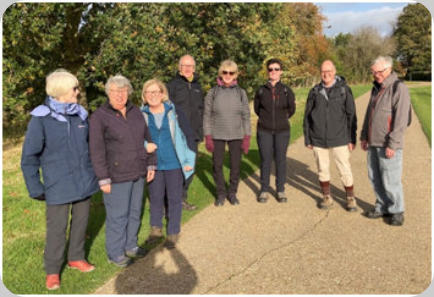
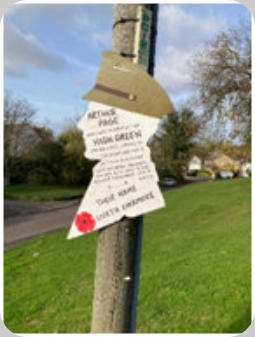
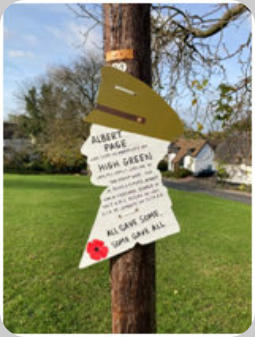
4th December - Christmas Tree Decorating
With
the
stalwart
efforts
of
Neil
G
and
Jo
M
one
of
the
St.
Georges
Nursing
Home
Christmas
trees,
decorations
and
lights
were
put
up
on
their
first
floor
landing.
Several
hoops
had
to
be
jumped
through
to
be
able
to
gain
access
to
the
Home,
evidence
of
lateral
flow
test,
full
vaccinations
and
masks
and
only
two
people
allowed
in.
The
Home
is
so
grateful
for
our
help
and
as
usual
we
were
presented
with
some
lovely mince pies.
Unfortunately
due
to
the
new
covid
variant,
omicron,
Richard
Cox
House
felt
it
too
risky
for
us
to
decorate their tree. Hopefully we will be able to do that next year.
Story by Bryony

14th December - Christmas Dinner Celebration
Clarice Wahlich said the Grace and President Steve Higginbotham read out a
surprise telegram believed to be from afar but in fact only from darker reaches of
Bassingbourn (Thank you Tony and Bryony).
A previously ordered meal was served very ‘Master Chef’ in its presentation, not the usual
“meat and two Veg” but very tasty!
Kash was disappointed that there was no coffee but eventually managed to charm the
young waitress in his inimitable way to find him a cup.
Words and pictures courtesy of The Rotarian
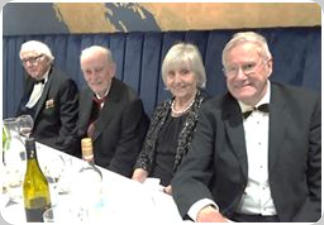
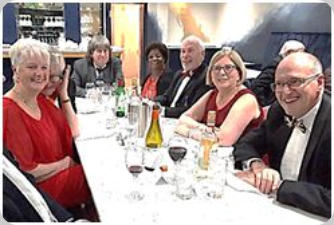

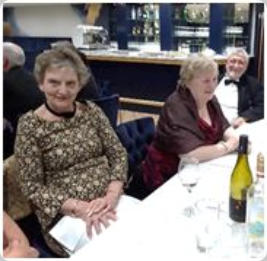
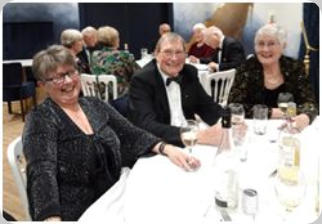

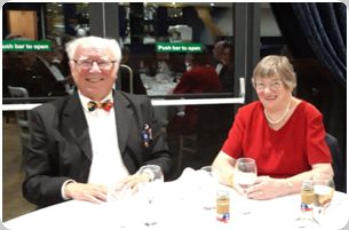
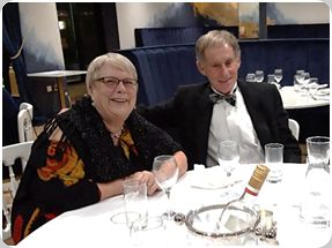
The annual Christmas Dinner for the Rotary Club of Royston was held on the 14th December at the Cambridge Country Club, Bourn.
Much thanks for the arrangements of this event must go to the diligent efforts by Vice President, Peter Mitton.
With DJs all pressed, medals burnished, (and trousers replaced by party frocks in the case of the ladies!!) we were greeted with a
welcoming glass of Prosecco and the conversation flowed amongst the 50 Rotarians and guests – there was much to catch up on
after so many months of virtual meetings by Zoom!
A group of 12 set off from Sawston for the first Rotary walk of 2022.
We
were
rewarded
with
a
sunny
and
not
too
cold
morning.
We
had
to
plough
through
a
few
backstreets
to
leave
the
town
(village?)
before
crossing
over
some
fields
that
luckily
weren’t
too
muddy.
As
we
approached
Babraham
an
attempted
shortcut
led
to
us
having
to
climb
a
double
barbed
wire
fence.
Luckily
it
was
a
bit
broken
down
and
with
mutual help we managed to negotiate it safely.
Pressing
on
we
arrived
on
the
outskirts
of
the
Babraham
Research
Campus,
an
impressive
420
acres
of
leading
edge
research
on
the
biological
working
of
the
body.
There
are
around
60
companies
on
the
site,
mostly
innovative
start-ups,
with
some
2,000
staff.
The
heart
of
the
campus
is
the
highly
prestigious
Babraham
Institute,
which
is
funded
by
various
Research
councils,
the
EU
(at
least
it
still
says
on
their
website)
and
charities.
Their
basic
research
is
spun
off
into
some
of
the
start-up
companies.
As
you
approach
there
is
an
impressive
looking
building,
which
used
to
be
an
agricultural
college
(and
presumably
before
that
someone’s
country
pile)
just the other side of the diminutive River Granta.
We
carried
on
alongside
the
Granta
and
the
paths
became
somewhat
muddier.
We
had
a
quick
walk
around
a
church
(literally
around
as
it
was
locked)
and
then
as
we
proceeded
along
we
had
our
first
mud
slide
with
Peter
Ross
taking
a
tumble.
Fortunately
the
only
damage
was
some
muddy
clothes.
The
path
went
through
some
woods
before
returning
to
an
open
path
across
fields.
Just
before
we
took
the
final
steps
back
into
Sawston
unfortunately
we
had
our
second
casualty
as
David
Beardwell
also
tumbled
over.
This
time
he
was
quite
shaken
up
and
so
after
a
brief
discussion
a
few
remained
with
David,
who
was
resting
on
a
wall,
while
Steve
dashed
off
to
get
his
car
to
retrieve
David.
The
rest,
mindful
of
the
3
hour
car
park
limit
and
prospective
£100
fine,
marched
quickly
along
the
main
road
to
speed
up
their
return.
Wisely
David
and
Liz
skipped
lunch
so
that
David
could
go
home
and
recuperate.
Luckily there was no permanent damage.
A
depleted
group
of
7
dined
in
the
otherwise
empty
but
good
quality
Jade
Fountain,
it
is
sad
to
see
such
a
nice
restaurant
struggling
for
customers.
They
were
very
friendly
and
understandably
did
their
best
to
encourage
us
to
spend
more,
it
can’t
be
economic
to
open for such a small clientele.
Words and photos by Ray Munden
9th January - Monthly Walk

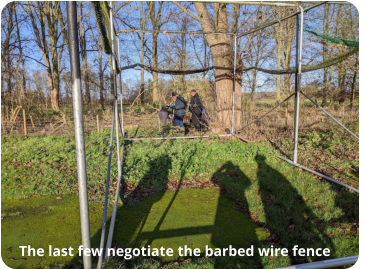

12th February - Results of Young Photographer Competition
The Rotary Club of Royston is delighted to be able to announce the results of its Young Photographer Competition. This year the
theme was “Colours of Nature” and the competition once again attracted some extremely high-quality pictures, particularly bearing
in mind the ages of the entrants. All the photographs entered can be seen below, and they will each step on at 5 second intervals.
The
Young
Photographer
Competition
is
a
well-established
and
successful
event
organised
and
promoted
by
Rotary
in
Great
Britain
and
Ireland
(
Rotary
GB&I)
.
The
Rotary
Club
of
Royston
organised
the
local
heat
for
the
up
and
coming
young
photographers
in
the
Royston area.
The junior category (7-10) was won by Joel Baker, aged 8, for his photo of the “Sands of Sound” in Shetland. The judges commented
that it is a beautiful seascape, technically very good, and a wonderful composition.
The winner in the intermediate category (11-13) was Olivia Frost, aged 12, for her picture of an avocet. The judges said the photo had
a wonderful texture which gave a sense of movement to the background and also the colours of the background set off the bird
perfectly.
Graeme Dargie, the Rotary club's chair of youth activities, said: “Once again, we were hugely impressed with the quality of all the
entries. I should like to thank all the young people who took part, as well as the judges - Keith Truman and Peter North, from
Melbourn Photographic Club, and Royston Rotary's own Ray Munden. My thanks, too, to Royston Photographic Club, which has
offered to provide a coaching session to our talented young photographers. Finally, our best wishes go to Joel and Olivia, whose
winning entries go forward to the Rotary District competition.”
1st February - Visit to The London Transport Museum
Twenty
four
Royston
Rotarians
and
partners
enjoyed
a
visit
to
the
London
Transport
Museum
at
Acton.
This
purpose-built
museum
houses
most
of
the
collection
which
are
not
on
display
in
the
main
museum
in
Covent
Garden.
Having
left
Royston
just
after
9.00
am, we duly arrived at the Museum and were ushered into a large assembly area where a black and white historical film was shown.
After
being
divided
into
three
groups,
each
led
by
a
‘Friend
of
the
Museum’
volunteer,
we
were
treated
to
a
2-hour
tour.
The
history
of
road
transport
was
illustrated
by
examples
of
horse
drawn
omnibuses,
trams,
trolley
bussers
(Oh,
yes
many
remembered
the
little
man
with
his
long
pole!!)
the
Route
Master
and
Green
Line
Country
Buses.
We
were
shown
examples
of
the
Underground
Railway
dating
back
to
the
late
1800s
and
more
recently
the
Tubes
where
we
were
able
to
sit
inside
on
the
‘Moquette’
seats.
Moquette
being
the
French
word
for
carpet.
It
was
introduced
to
London
Transport
in
1920s
as
being
hard
wearing.
Each
tube
line
had
its
own
moquette design. (As a bit of ‘useless’ information, Moquette can be purchased from the Museum at £20 per metre.)
Finally
on
the
Mezzanine
floor
there
was
a
display
of
historical
posters
and
signs
and
examples
of
the
ingenious
map
of
the
Underground
Stations
based
on
an
electrical
circuit
devised
by
Harry
Beck,
a
cartographer
back
in
1931.
Updated
regularly
and
still
used today. There was actually one made of Lego!
Having
briefly
stopped
at
the
Museum
shop
(as
one
does)
we
reboarded
the
coach
and
drove
to
Sanzio
Restaurant
in
Willesden
Green where we enjoyed an excellent pre ordered meal before we made our way back to Royston.
Many
thanks
to
David
Beardwell
for
his
excellent
organisation;
also,
thanks
to
Di
Charles
for
this
text
and
to
Linda
Berks
for
the
photographs (click on each one to enlarge).

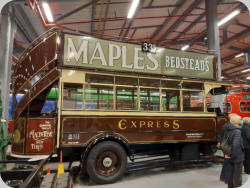
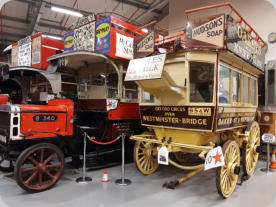
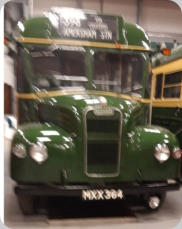
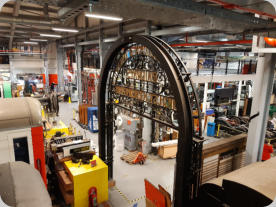
13th February - Monthly Walk
This
month’s
walk
took
us
into
a
new
area.
Sandra
Scott
was
the
organiser
and
she
had
planned
a
walk
on
Dunstable
Downs.
We
met
in
the
car
park
at
the
Chiltern
Downs
Centre.
As
we
opened
our
car
doors
to
get
out,
we
got
a
better
idea
of
the
weather
conditions.
It
was
very
windy
and
rather
cold.
The
eight
people
who
were
walking
were
very
well
wrapped
up
as
we
set
off.
Sandra
assured
us
we
would
be
out
of
the
wind
before
too
long.
The advantage of being so high up was that we had fantastic views over the Downs.
We
walked
along
the
side
of
the
hill
and
could
see
Ivinghoe
Beacon
in
the
distance.
Once
we
had
rounded
the
corner
we
had
a
good
view
of
the
Whipsnade
lion
carved
into
the
hill.
We
were
soon
out
of
the
wind
and
enjoying
a
walk
through
the
fields.
The
footpaths
were
mainly good but we did encounter a particularly muddy stretch which required some deft footwork to avoid an embarrassing fall.
John
and
Ray
were
at
the
front
at
this
stage
and
so
busy
chatting
they
walked
on
past
the
turn
off.
Sandra
had
to
call
them
back
to
get
them
on
track.
Soon
we
arrived
at
a
clearing
which
had
an
information
board
telling
us
we
had
arrived
at
the
Whipsnade
Tree
Cathedral.
This
is
a
9.5
acre
garden
in
the
village
of
Whipsnade.
It
is
planted
in
the
approximate
form
of
a
cathedral
with
grass
avenues
for
nave,
transepts,
chapels,
cloisters
and
‘walls’
of
different
species
of
trees.
We
stopped
for
a
break
here
before
exploring
the
grassy
paths
of
the
cathedral.
The
walk
continued
through
open
fields
and
soon
we
were
able
to
see
the
sculpture
/
chimney
on
the
top
of
the
hill
and
visitor
centre
where
we
had
started.
The
final
part
of
the
walk
was
windy.
It
was
a
fairly
short
walk
but
most
enjoyable.
It’s
always
good
to
try
something
different
and
we
all
enjoyed
exploring a new area.
Lunch
was
a
short
drive
away
at
Old
Hunter’s
Lodge.
This
was
a
great
pub
and
we
all
enjoyed
our
lunch
choices.
We
had
a
friendly
waiter
who
looked
after
us
very
well.
Ray
even
managed
to
persuade
him to put extra chocolate sauce on the profiteroles!
The
weather
forecast
hadn’t
been
good
for
Sunday
but
we
had
a
bracing
walk
and
the
rain
only
started once we were having lunch. Huge thanks to Sandra for organising a great walk.
Clarice
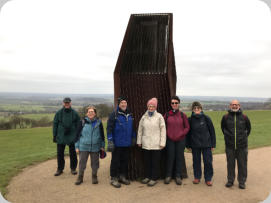
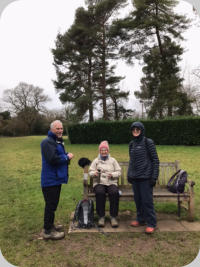
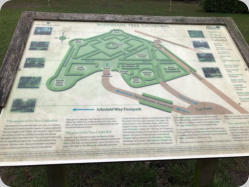
11th February - Community Breakfast Restarted
After
a
break
of
exactly
25
months
due
to
the
covid
pandemic,
we
had
a
good
turnout
of
11
people
for
the
Community
Breakfast
re-
start
meeting,including
2
new
members.
Karin
Weston
kindly
chaired
the
meeting
in
Neil’s
unavoidable
absence
and
the
group
was
very happy to be able to meet in person again – and to have the usual excellent Old Bull Inn breakfast!
We
had
a
useful
update
from
each
person
and
a
discussion
about
possible
future
Speakers,
coming
up
with
several
very
good
possibilities.
As
the
group’s
primary
purpose
is
mutual
support
for
group
leaders,
we
discussed
how
to
give
enough
time
also
for
members
to
raise
their
own
group’s
issues
and
concerns
during
meetings,
and
so
benefit
from
others’
experience,
techniques
and
practical solutions.
Full details of the Community Breakfast can be found on the Rotary Club’s main website
here
The
next
meeting
is
on
Friday
11th
March
at
7.30am
for
Breakfast
at
8.00am
at
the
Old
Bull
Inn,
contact
breakfast@roystoncommunity.org.uk
for an invitation.
Rotary
Club of Royston

President: Stephen Higginbotham

9th March - Visit to HMS Belfast
A party of 19 Rotarians, family and friends set off at 9am from Royston Golf Club by Richmond coach, destination - the south London
Embankment where the famous HMS Belfast is moored. She is a Town-class light cruiser that was built for the Royal Navy and is
now permanently moored as a museum ship on the River Thames in London, operated by the Imperial War Museum. Construction
of Belfast, one of ten Town-class cruisers, began in December 1936. She was launched on St Patrick's Day 1938. Commissioned in
early August 1939 shortly before the outbreak of the Second World War,
On arrival, most of the party made directly for the Stokers Cafe on the ship for a refreshing cup of coffee. Thereafter we were free to
wander around and explore the ship, all nine decks of it. Typically for a warship, the stairways leading between each deck are very
steep and required facing the rungs when ascending AND descending (unlike the sailors who previously served on her). But there
were other dangers to look out for when exploring and poor David B came a cropper somewhere near the bow (that’s the pointy bit)
leaving a very large bruise on his chin and some other cuts and bruises. Fortunately HMS Belfast boasted a 4-berth sick bay plus an
operating theatre as well as a dispensary and dental surgery to cater for various accidents when at sea!
The Belfast is clearly not an aircraft carrier but it used to have a plane on board. When you look at the structures above deck you’ll
notice there is a conspicuous gap between the front and rear structures where a crane is currently sited. This is because a
reconnaissance plane used to sit here and it was launched using a catapult. This increased the range of the Belfast's vision, but once
radar came along, the plane became obsolete and they got rid of it.
HMS Belfast was extremely crowded, so many of the crew would have to sling their hammocks in the corridors. When walking along
these corridors you can spot the hooks high up on the walls where the crew would attach their hammocks when they needed some
kip.
By 1pm some of the party set off to look for lunch in one of the numerous eating places nearby. This gave us a chance to walk past
Hays Wharf which used to accommodate huge tea clippers to unload their cargo off the main river side. Nowadays this whole area
has been completely renovated and the dock filled in but there is a huge modernist sculpture called The Navigators sitting in it’s own
pool of water and with moving oars at each side.
We all met up at 3pm at London Bridge Pier to take the boat down to Greenwich where we would meet our coach. The trip was very
pleasant in the sunshine and our boat stopped off at a number of places to pick up and put off passengers. On arrival at Greenwich
we saw the huge Cutty Sark which these days is completely encased with steel around its hull following the fire in 2007 which
destroyed three of its decks (now thankfully completely restored to its former glory).
We set off back to Royston through the busy London traffic and arrived back at Royston golf club at 5.30, exactly on time.
Many thanks must go to the Sports and Social Committee for arranging this brilliant day out and specifically to Ray Munden who
arranged it all with such precision.
Photos courtesy of Ray and Bryony. This album will step on every 8 seconds or use the white arrows to step forward or back.

13th March - Monthly Walk
This
month’s
walk
was
organised
by
David
and
Liz.
The
promise
of
a
flat
route
encouraged
more
than
twenty
people
to
join
in.
We
met
outside
The
Green
Dragon
pub
in
Chesterton
in
Cambridge
where
a
large
and
happy
group
set
off
in
beautiful
sunshine
over
the
footbridge
to
the
far
side
of
the
river
Cam.
Walking
was
easy
along
the
towpath
and
it
wasn’t
long
before
we
saw
Neil
and
his
neighbour,
Phyllis,
walking
on
the
other
side
of
the
river.
Help
was
at
hand
as
they
were
able
to
cross
over
a
very
impressive
new
footbridge
(The
Chisholm
Way)
to
join us. We were able to watch the rowers, out in force, enjoying the river.
A
little
further
on
we
left
the
river
walking
across
the
fields
to
Fen
Ditton.
Here
we
were
able
to
see
the
houses
which
had
formerly
been
unloading
bays
for
cargo
brought
up
on
the
river.
After
a
stop
at
the
war
memorial,
we
walked
on
along
the
road
to
rejoin
a
footpath.
This
was
quite
narrow
and
we
were
frequently
having
to
move
aside
for
the
many
serious
runners
who
were
part
of
a
race.
We walked under the A14 bridge and reached Baits Bite Lock where we crossed over the bridge and had our coffee break.
With
the
sun
still
shining
and
beautiful
blue
skies
we
continued
our
walk
back
on
the
opposite
bank
of
the
Cam.
Here
we
encountered
cyclists
many
keeping
pace
with
the
rowing
boats
and
shouting
instructions
to
the
rowers.
Before
too
long
we
were
back at the footbridge and shortly after we found our way through the houses to get back to the pub.
The
peace
was
broken
by
a
car
alarm
going
off
but
in
true
Rotary
style
we
all
walked
by
pretending
we
didn’t
know
Bryony
who
was
frantically trying to stop the noise coming from her car.
We
enjoyed
a
good
lunch
at
the
Green
Dragon.
The
inscription
over
the
fireplace
was
a
bit
confusing
so
a
photograph
is
included
for
you
to
make
of
it
what
you
will.
During
our
lunch
it
started
to
rain
heavily
and
we
realised
how
lucky
we
had
been
to
enjoy
our
riverside walk in such lovely sunshine.
Thanks to David and Liz for organising a great walk and finding a pub to accommodate so many of us.
Clarice.
A note about The Green Dragon pub.
The
Green
Dragon
is
arguably
the
oldest
coach
house
&
pub
in
Cambridge.
Housing
famous
people
like
M.P.
Oliver
Cromwell
(1599-
1658)
who
reportedly
sat
in
the
pub
with
his
friends
practicing
their
knife
throwing
skills
into
the
fire
lintel
that
can
still
be
seen
today. J.R.R. Tolken (1892-1973) often visited the pub for inspiration for writing the likes of The Hobbit and Lord of the Rings.
Tony B
All
the
pictures
taken
on
the
walk
can
be
seen
in
the
moving
album
below.
It
will
step
forward
every
8
seconds
but
can
be
manually
moved using the arrows at either side.

15h March - Aid for Ukraine
Ukraine: We Lend a Hand
What
is
happening
in
Ukraine,
and
what
can
we
do
about
it?
Our
leaders
face
the
terrible
problem
of
how
best
to
deal
with
the
politics,
the
strategy,
the
frightfulness.
Ordinary
people
also
face
a
challenge:how
to
help
the
two
million-plus
other
ordinary
people
–
mainly
the
elderly,
mothers
and
children
-
who
have
fled
their
shattered
homes
and
are
now
homeless,
hungry
and
frightened
in
neighbouring
countries.
What
we
see
on
our
TV
screens is a scale of misery and horror not seen in Europe for 80 years.
The
club
is
supporting
the
efforts
of
Sofia
and
Leonardo
Mitrofan
(she
Romanian,
he
Italian)
who
run
the
Chequers
in
Barley.
They
organised
a
local
collection
of
necessaries
for
refugee
families
in
Romania
-
mostly
food
and
medical/hygiene
supplies)
which
quickly
grew
until
three
vans
were
needed
to
transport
the
load.
At
the
Romanian
end
of
the
journey,
the
Rotary
Club
of
Braila
will
assist
in
distribution.
Peter
Homent,
who
lives
in
nearby
Great
Chishill,
as
well
as
several
other
local
Rotarians,
had
donated
goods,
and
suggested
that
the
club
could
help
by
sponsoring
the
initiative.
Club
members
quickly
bought
into
the
idea,
and
we
shall
be
helping to pay for the costs of the project when the vansarrive home.
On
Saturday
evening
President
Steve
and
and
wife
Sue
went
to
the
Chequers
to
see
the
three
vans
–
one
driven
by
Leonardo,
set
off
at
dusk
on
their
long
journey
east.
It
was
an
emotional
occasion,
and
the
Chequers
was
packed
with
well-wishers.
Barley’s
vicar
Ruth
Pike
blessed
the
project
and
the
three
drivers,
and
then
the
vans
were
gone.
BBC
Look
East
covered
the
story
the
following
Monday
(better
late
than
never!),
and
on
Tuesday
afternoon
we
had
the
great
news
that
the
vans
had
arrived
and
were
already
distributing the goods to refugees from Odessa.
In
addition
to
the
club’s
support
for
the
Chequers
initiative,
more
help
for
will
come
from
the
individual
donations
made
by
Royston
Rotarians.
These
will
go
to
a
Rotary-nominated
charity
which
is
best
placed
to
help
those
in
most
need.
At
time
of
writing
the
club’s
total pledged donations exceed £1,600.
The
Ukraine
crisis
may
be
with
us
for
months
or
years;
perhaps
we
dare
not
imagine
how
this
awful
thing
will
play
out.
But
Rotary,
and the club, will continue to do what we can in the name of humanity and peace.

22nd March - Charter Night (60th Anniversary)
It
was
a
glittering
turnout
of
Rotarians,
guests,
dignitaries
and,
of
course
past
club
members
who
met
at
Fitzwilliam
College,
Cambridge
for
our
60th
anniversary
Charter
Night.
The
Royston
Rotary
Club
had
been
formally
granted
its
charter
on
23rd
March
1962 so technically we were a day early - as if it mattered.
President
Steve
Higginbotham
presided
over
the
evening
and
was
honoured
to
welcome
the
Queen’s
representative
in
Hertfordshire,
High
Sheriff
Lionel
C
Wallace
DL.
Also
present
was
Jane
Mordue
the
Rotary
District
1260
Governor
(which
is
the
district
within
which
the Royston Rotary Club belongs) and also welcomed Deputy District Governor Andy Calvert.
Following
the
pre-dinner
drinks
where
old
and
new
friends
caught
up
we
were
called
into
dinner
where
President
Steve
formally
welcomed
all
the
guests
and
then
invited
Rotarian
David
Izod
to
say
grace,
which
he
did
with
great
aplomb.
And
now
the
meal
could
start:
a
herb
risotto
with
baby
leeks
and
feta
cheese
to
start
followed
by
roast
guinea
fowl
with
gnocchi
and
fresh
vegetables.
The
pudding was apple terrine with salted caramel ice cream followed by coffee and mints.
President
Steve
proposed
the
Loyal
Toast
and
then
addressed
the
assembly
relating
the
history
of
the
Royston
Rotary
Club
and
its
various
ups
and
downs
over
the
last
60
years.
He
particularly
highlighted
the
recent
help
the
club
had
given
for
the
Ukrainian
refugee
crisis,
both
in
goods
and
services
and
monetary
terms.
Steve
then
introduced
District
Governor
Jane
Mordue
who
also
spoke
from
the
heart
about
how
Rotary
has,
and
continues
to,
help
the
Ukrainian
refugees
and
that
we
mustn’t
forget
those
too
who
are
fleeing from Syria, Afghanistan and other persecuted humans who seek sanctuary in the UK.
It
was
now
the
turn
of
the
High
Sheriff
of
Hertfordshire
Lionel
Wallace,
resplendent
in
the
uniform
of
his
high
office
with
frock
coat,
silk
cuffs,
silk
cravat
and
a
very
shiny
and
sharp
silver
sword.
Lionel
congratulated
the
club
on
reaching
this
milestone
of
60
years
and
spoke
a
little
about
his
responsibilities
representing
the
Crown
in
Hertfordshire.
He
then
proposed
a
toast
to
The
Royston
Rotary
Club which was responded to in a witty and light hearted way by Rotarian Kash Sharma.
After
the
traditional
final
toast
“Rotary
and
Peace
the
World
Over”
the
dinner
party
split
up
to
resume
conversations
friends
not
seen
for
some
time
such
as
Peter
and
Pam
Franks,
Guy
and
Julia
Garfitt
and
Noel
Cooper.
Many
took
the
time
to
study
the
original
charter
document and also the photographs of the founder members of the club and a later photo of Rotarians taken in the mid 1990’s
A great evening most efficiently arranged thanks to our vice president, Rotarian Peter Mitton.
This
album
below
has
a
few
of
the
photos
of
the
evening
-
they
will
step
forward
every
eight
seconds
but
you
can
manually
control
them with the white arrows at either side.
22nd March - Charter Night (60th Anniversary)
10th April - Monthly Walk
The
April
walk
was
a
four
mile
circular
amble,
starting
and
finishing
at
my
local
pub,
The
Three
Horseshoes,
in
Comberton. This pub opened in 1861.
The
sun
shone,
thankfully,
and
seventeen
intrepid
walkers
set
off,
once
Kasifa
nd
her
grandchildren
found
us!
Walking
north,
the
first
stop
was
beside
the
village
pond,
and
the
village
sign
which
depicts
a
lady
handing
out
fish
-
more
later.
Green
End,
the
first
leg,
is
an
attractive
residential
road,
named
after
Sir
Henry
Green,
Chief
Justice
to
the
Queen’s
Bench,
who
was
beheaded
in
1399
as
one
of
Richard
2nd’s
councillors.
A
large
property,
Manor
Farm,
with
beautiful
gardens
was
admired,
although
all
had
to
take
my
word
for how beautiful the gardens are, as they are not visible from the road.
Then
followed
a
stretch
of
footpath
pointing
toward
Hardwick,
lined
on
either
side
by hedges just bursting into leaf and blossom.
This
opened
on
to
open
land,
and
we
headed
east,
with
wonderful
views
of
rolling
countryside, although perhaps only a mile from the Cambridge City boundary.
After
the
mandatory
coffee
stop,
we
pointed
south,
back
into
Comberton,
to
pick
up
a
short
stretch
of
the
Drift,
a
byway,
before
turning
right,
and
returning
via
the
church towards the pub,
Here I pointed out the reason behind the fishes on the village sign:-
There
are
seven
acres
of
land,
owned
by
the
Herringland
Trust
(of
which
I
am
the
Chairman
of
the
Trustees,
so
it
is
my
land!).
There
is
reference
to
the
Township
of
Comberton
owning
this
land
in
1567,and
there
is
evidence
that
in1783
the
land
was
let
for
£5.6sh
and
the
rent
was
used
to
buy
barrels
of
herrings
to
distribute
to
the
poor
of
the
village.
There
are
no
herrings
now,
but
the
income
from
the
rent
is
to
provide
help
in
the
community
when
required.
Finally, back to the pub, where thirteen of us enjoyed our Sunday lunch after a very pleasant walk.
Words by Peter Mitton, photos by Bryony. Click on any image to enlarge and then right click to save or copy.
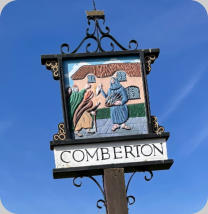
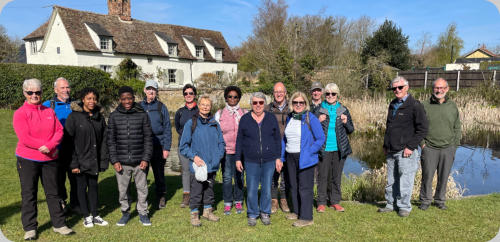
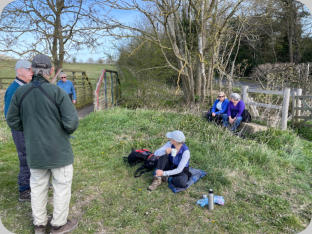
6th April -Visit to Cambridge Museum of Technology
On
Wednesday
6th
April
14
members
of
the
club
visited
the
Cambridge
Museum
of
Technology.
On
arrival
we
were
greeted
by
the
curator,
Pam
Halls,
who
took
us
on
a
guided
tour
showing
us
the
very
impressive
1894
steam
pumps,
the
rather
less
impressive
gas
engines
installed
in
1909
and
the
very
unimpressive
electric
pump
installed
in
1937.
The
original
engines,
however,
operated
from 1894 until the whole set-up became redundant in 1968 when a new electric pumping station was built on a nearby site.
Pam
guided
us
through
the
museum
for
about
an
hour,
eloquently
relating
its
history
together
with
anecdotes
on
the
people
who
worked
there
over
the
years.
Until
the
late
18th
century
Cambridge’s
sanitation
was
very
much
the
same
as
other
major
cities
throughout
the
country
and
was
dominated
by
the
“bucket
and
chuck
it”
system.
In
the
late
18th
century,
following
diseases
such
as
typhoid
and
cholera,
things
got
so
bad
that
the
city
decided
to
construct
a
new
sewage
system
which
resulted
in
a
pumping
station
being
built
at
Riverside.
This
now
forms
the
core
of
the
Museum
of
Technology.
The
system
installed
involved
the
construction
of
two
steam
operated
pumps
constructed
above
a
40
foot
deep
sump
into
which
Cambridge’s
foul
and
surface
water
was
drained.
The
pumps
pumped
the
sewage
up
to
Milton
where
it
was
spread
on
the
fields
as
fertilizer.
Originally
the
steam
was
raised
from
boilers
that
burned
all
of
the
rubbish
collected
from
Cambridge
in
an
early
recycling
scheme.
Eventually
not
enough
rubbish was produced and the fuel reverted to coke.
We
were
taken
to
the
areas
where
the
waste
was
first
gathered
and
sorted,
with
anything
that
was
salvageable
for
reuse
or
recycling
was
taken
out.
We
were
then
shown
the
three
enormous
boilers
which
raised
the
steam.
From
there
we
went
to
view
the
180
foot
chimney serving the boilers.
We
were
told
that
when
the
volunteers
took
over
the
museum
the
brickwork
at
the
top
of
the
chimney
was
crumbling
and
needed
repairing
and
repointing.
Quotations
were
sought
for
the
work
but
the
two
companies
approached
quoted
sums
which
were
far
higher
than
the
museum
could
afford
to
pay.
Subsequently,
one
of
the
volunteers
was
in
the
north
of
the
country
and
found
himself
in
Bolton
and
so
decided
to
knock
on
Fred
Dibnah’s
door
inviting
him
to
advise
them.
Fred,
as
ever,
was
enthusiastic
and
offered
to
do
the
job
for
£6000,
a
great
deal
less
than
the
quotes
they
had
previously
received.
Part
of
the
deal
apparently
was
that
Fred
would
not
have
to
pay
any
hotel
bills
but
the
volunteer
members
would
fund
accommodation
for
Fred
,
his
wife
and
his
son
while
he
was
in
Cambridge.
We
were
told
that
Fred
was
happy
to
give
talks
when
not
working
on
the
chimney
for
which
the
museum were able to charge and that the revenue raised in this way more than paid for Fred’s charges.
In
addition
to
the
original
pumping
station
there
is
a
large
collection
of
old
engines
and
equipment,
much
of
which
has
been
donated
by
local
companies
as
the
equipment
became
outdated
and
uneconomic
to
operate.
There
is
also
an
exhibition
room
set
up
with
a
great
deal
of
exhibits
covering
the
story
of
Pye
in
Cambridge
and
of
the
Cambridge
Instrument
Company,
both
with
a
great
deal
of
original
equipment.
The
visit
was
very
much
enjoyed
by
all
who
attended
and
all
praised
Pam
Halls
on
the
quality
of
her commentary and for her obvious enthusiasm for the museum and its exhibits.
Visit was arranged by Rotarian David Easthope who also wrote this script and supplied the photo.

3rd May - Visit to Peacock’s Auction House
A
large
group
of
Rotarians
and
their
Partners
descended
upon
Peacock’s
Auction
House
in
Bedford
last
Tuesday.
Their
headquarters
is
on
a
large
industrial
complex
in
a
modern
purpose-built
unit
with
at
least
four
individual
auction
rooms
(they
hold
four
auctions
every Saturday selling about 2,500 items each time).
After
meeting
up
for
a
welcoming
coffee
we
were
given
an
introductory
talk
by
Lindsey
and
Matthew,
two
of
Peacocks
auctioneers.
They
explained
the
history
of
the
firm
and
about
it’s
recent
move
from
the
centre
of
Bedford
into
their
current
premises.
There
were
some
amusing
anecdotes
about
items
that
had
been
auctioned
by
them
over
the
years
and
it
was
explained
how
busy
it
usually
is
on
a Monday and Tuesday with the public bringing in items for the next sale with others picking up items purchased in the previous sale.
We
were
then
given
a
tour
of
the
various
auction
areas
in
the
building,
finishing
up
in
their
Sale
Room
1
which
was
all
set
up
for
the
next
Saturday
sale.
Here
they
had
prepared
a
quiz
for
us
with
five
items
in
the
room
having
been
pre-selected
and
we
were
invited
to
answer
questions
on
each
to
test
our
knowledge
over
the
next
30
minutes.
This
caused
quite
some
head
scratching
but
eventually
we were invited to sit while both Lindsey and Matthew gave us the answers and explanations (in red below).


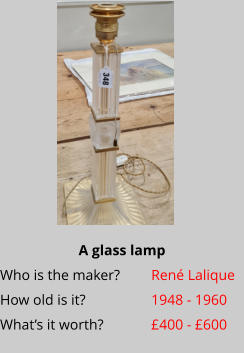
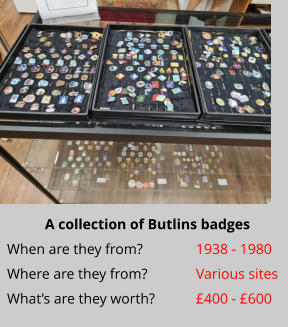
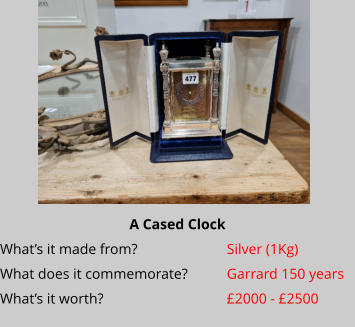
Following
the
quiz
we
were
led
back
upstairs
to
the
visitor’s
cafe
where
we
enjoyed
a
very
satisfying
lunch
before
departing
back
to
our homes.
This
was
a
most
interesting,
instructive
and
enjoyable
outing
and
many
thanks
must
go
to
our
Sports
and
Social
Committee,
and
particularly to Peter Ross as the prime organiser.
Words and photos by Tony B
2nd May - Historic Vehicle Show
T
he
Historic
Vehicle
at
the
Royston
May
Day
Fayre
proved
very
successful.
People
were
demob
happy
after
covid
restriction
were
lifted
and
were
keen
to
get
their
vehicles
out
on
display.
As
a
result
we
had
a
pleasing
variety
of
around
170
vehicles
on
display,
including
some
40
motorbikes,
a
steam
engine
and
our
the
usual
child
pleasing
tractor.
The
weather
was
quite
kind,
while
not
very
sunny there was no rain and a reasonable temperature.
President
Steve
chose
Ken
Stratton's
beautiful
Triumph
Tiger
110
as
best
bike
in
show.
Steve's
choice
for
best
car
in
show
was
a
beautiful
two-tone
1958
Nash
Metropolitan
owned
by
John
and
Rosemary
Dowling.
Deputy
Mayor
Marguerite
Phillips
awarded
the
trophy for best vehicle in show to a 1947 MG TC that had been lovingly restored by Ray Brand.
The
charity
buckets
collected
a
pleasingly
large
sum,
over
£300,
much
more
than
we
have
ever
received
before.
This
included
a
generous donation from a new venture, our first ever commercial stall, which was selling small model cars.
It
is
very
rewarding
to
see
how
the
show
has
grown
over
the
last
decade,
from
having
around
80
to
90
vehicles
to
the
current
170
and
with
substantial
sums
raised
for
charity.
The
distribution
list
has
more
than
doubled
from
218
(only
10%
by
Email,
the
rest
snail
mail)
to
448
(65%
by
Email,
much
better
but
still
frustrating).
And
of
course
we
now
have
two
shows
rather
than
one.
We
also
have
to
thank
the
generosity
of
previously
David
Smyth
from
UK
Hacker
Young
but,
this
year
through
Peter
Homent
from
Hardcastle
Burton
LLP for franking the paper posts and saving us a significant cost.
Thanks also to everybody who turned out to act as marshals.
Words by Ray Munden, photos courtesy of Neil Heywood and Ray Munden.
To see the complete photo album click here
.














